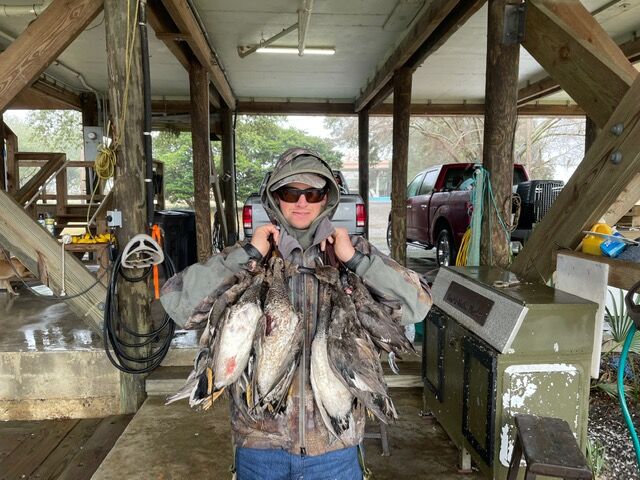Estimated 2 million ducks in La. in January; 1.23M in SW region
Published 4:00 am Sunday, January 29, 2023

- Lafayette native Martin Mouton holds a strap full of ducks after hunting with a cousin Jan. 1 in the marsh near Pecan Island. The Charleston, South Carolina, outdoorsman who builds M&M Custom Rods saw some of the many ducks in southwest Louisiana. Jason Olszak, Louisiana waterfowl program manager, conducted an aerial waterfowl population survey the next week along the coast from state line to state line and reported an estimated 2 million total ducks there and around Catahoula Lake.
As 2022-23 duck hunting winds to a close today in Louisiana, many duck hunters may have seen more pintails, mallards, green-winged teal, canvasbacks and northern shovelers this month than the rest of the season.
Those who hunted ducks in the southwest region more than likely got a look at more ducks overall this month than they did in January 2022. Based on field reports and social media postings, Teche Area duck hunters enjoyed more consistent success down the stretch than over the first two months this season.
Louisiana Department of Wildlife and Fisheries waterfowl biologists counted an estimated 2 million ducks while conducting their monthly aerial waterfowl survey the first week of January for southwest and southeast Louisiana, as well as the Little River Basin (formerly Catahoula Lake area). Jason Olszak, the state’s waterfowl program manager, said the total number of ducks in the latest survey was 3 percent lower than both the December 2022 and January 2022 estimates of 2.1 million ducks.
Also, the estimate is minus 16 and minus 23 percent than the most recent 10-year and 20-year averages, respectively, for January. The 2 million ducks also represent a 34-percent drop compared to the long-term average and only blue-winged teal (plus-35 percent), ring-neck duck (plus-90 percent) and canvasbacks (plus-204 percent) are above their long-term averages.
According to their count during aerial flights along sectors across the coast, there were an estimated 145,000 blue-winged teal, 330,000 ring-necks and 233,000 canvasbacks.
Louisiana’s 2022-23 duck season ended today in the West Zone and the East Zone. Also, goose hunting drew to a close today in the East Zone and ends Feb. 5 in the West Zone. However, the conservation order (light geese-only) continues in the East Zone through March 5 and resumes Feb. 6-March 5 in the West Zone.
Of those 2 million ducks along the Coastal Zone and Little River Basin, 203,000 were pintail, an increase of 109 percent compared to January 2022; 427,000 green-winged teal, up 59 percent over January 2022; 37,000 mallard, an increase of 61 percent compared to January 2022, and 190,000 shovelers, up 37 percent over January 2022, Olszak noted in his report released Jan. 18.
Other duck numbers were far less positive. Decreases were noted in scaup (36,000, down 91 percent); blue-winged teal (145,000, down 37 percent); mottled duck (19,000, down 17 percent), and ring-necks (33,000, down 16 percent), according to the recent survey. Also, the veteran waterfowl biologist noted the gray ducks (gadwall) estimate of 359,000 was 5 percent higher than last January’s record low of 341,000 and the 19,000 mottled ducks is the lowest January estimate for the species on record.
Olszak reported the total estimate comes in 34 percent below the long-term average and only blue-winged teal (plus-35 percent), ring-necks (plus-90 percent), and canvasbacks (plus-204 percent) are above their long-term averages.
Southwest Louisiana’s duck numbers totaled 1.23 million (compared to 1,097,000 in January 2022) and were led this month by green-winged teal at 345,000. The other species in descending order were gray ducks, 272,000; shoveler, 188,000; blue-winged teal, 80,000; pintail, 79,000; mallard, 30,000; mottled duck, 9,000, and widgeon, 6,000, for a total of 1,009,000 dabbling ducks.
Also in this region, there were 6,000 scaup and 212,000 ring-necks for a total of 218,000 diving ducks.
The table was set pretty good for ducks in this region in January, Olszak pointed out, just like it was in December. Water was widespread across the landscape with many acres available across the agricultural regions.
However, he reported, increasing daily activity in and around the numerous crawfish ponds coincided with the presence of fewer ducks. There were a few exceptions, he wrote, in the unworked, harvested rice fields that harbored large flocks of ducks and geese.
While duck distribution was just as widespread, the region’s largest groups were between Pecan Island and Grand Chenier. And many of the larger groups were located between the Intracoastal Waterway and Louisiana 82.
While flying the transect lines, Olszak and his staff saw an estimated 44,000 light geese and 2,000 specklebelly geese between and along transects with the largest concentration west of Gueydan.





